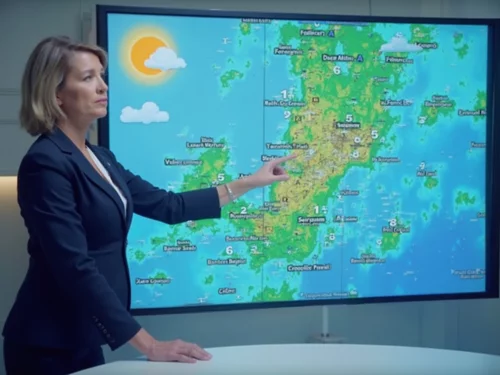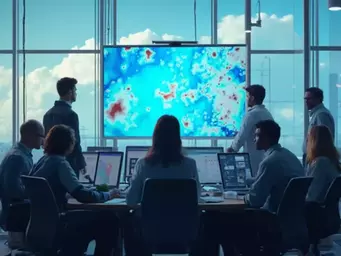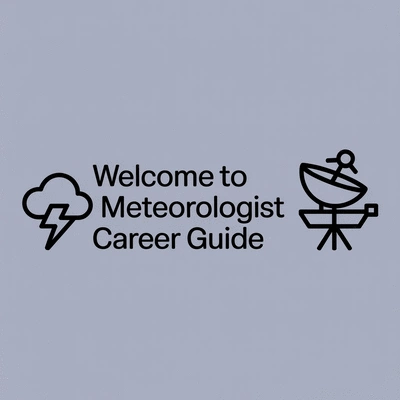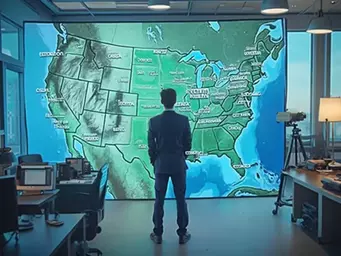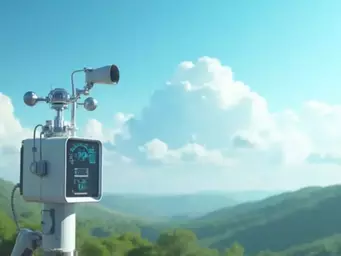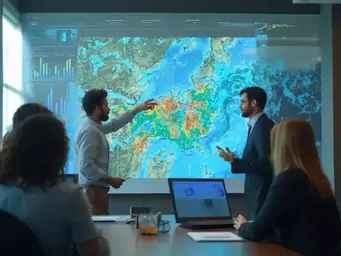Effective communication can reshape the way people perceive and respond to weather forecasts. With the right strategies, meteorologists can greatly enhance public understanding and safety. Let's delve into the essential skills that can elevate weather communication.
What You Will Learn
- The importance of tailoring messages to your audience for better understanding.
- How simplifying complex meteorological language can enhance clarity.
- The role of visuals, such as maps and graphics, in making forecasts more engaging.
- Techniques for practicing storytelling to foster emotional connections with audiences.
- Strategies for continuous improvement and learning in communication skills.
Communication Strategies for Meteorologists
Meteorologists play a crucial role in public safety, which heavily relies on their ability to communicate complex weather information effectively. The visual below outlines key strategies to enhance this communication.
1. Public Engagement
- • Provide clear, actionable crisis information.
- • Engage through educational programs.
- • Build trust by being transparent.
2. Core Communication Skills
- • Simplify complex technical terms.
- • Utilize visuals for better understanding.
- • Practice active listening.
3. Empathy & Connection
- • Recognize emotional impact of weather.
- • Adjust tone based on audience needs.
- • Encourage two-way community dialogue.
4. Presentation Mastery
- • Focus on articulation and clarity.
- • Utilize body language and charisma.
- • Employ voice modulation & storytelling.
The Importance of Effective Communication in Meteorology
Have you ever wondered how meteorologists convey complex weather information to the public? Effective communication is crucial in meteorology, as it directly impacts how communities understand and respond to weather events. As a dedicated meteorologist and educator, I often emphasize that our role goes beyond just interpreting data—it’s about connecting with people!
In my experience, communicating weather forecasts in a clear and engaging manner can significantly enhance public awareness and preparedness. Let’s explore the various facets of communication in meteorology, starting with the vital role we play in public engagement.
Understanding the Role of a Meteorologist in Public Engagement
As meteorologists, we serve as the bridge between scientific data and the public's understanding. Our duty is to inform, educate, and sometimes entertain while delivering forecasts. This involves not only presenting facts but also sharing stories that resonate with the audience.
- Providing clear, actionable information during severe weather alerts. As outlined by the National Weather Service, effective forecasting is critical for public safety.
- Engaging with the community through educational programs.
- Building trust by being transparent about uncertainties in forecasts. The National Oceanic and Atmospheric Administration (NOAA) stresses the importance of clear communication to avoid misunderstandings during hazardous weather.
It’s rewarding to see how effective communication can empower individuals and communities. For example, when people clearly understand a weather warning, they are more likely to take the necessary precautions. It’s all about making that vital connection!
Why Communication Skills Matter in Weather Forecasting
In the fast-paced world of weather forecasting, having strong communication skills is non-negotiable. We need to translate complex meteorological data into understandable language for various audiences. This means being concise while also conveying essential information!
- Using simple language to describe technical terms.
- Employing visuals to enhance understanding of forecasts.
- Practicing active listening to address audience concerns.
The better we communicate, the more effectively we can prepare and inform our communities. This is essential for ensuring that our audiences stay safe and well-informed, especially during extreme weather events. As highlighted by Weather.gov, accurate and timely weather forecasting, coupled with clear communication, is paramount for Caribbean communities.
Empathy in Communication: Bridging the Gap with the Audience
At the heart of effective communication lies empathy. Understanding the feelings and concerns of our audience allows us to tailor our messages appropriately. Imagine delivering a severe weather warning to a community that has just experienced a tragedy; your approach must be sensitive and compassionate.
- Recognizing the emotional impact of severe weather events.
- Adjusting tone and content to reflect audience needs.
- Encouraging community feedback to foster a two-way dialogue.
By practicing empathy in our communication, we not only convey information but also build trust and rapport with our audience. This connection is what keeps people engaged and responsive to our forecasts.
Mastering Presentation Skills for Weather Communication
Presentation skills are just as important as verbal communication. Whether we’re delivering a forecast on TV or speaking at a community event, how we present information can greatly influence its reception. Let’s dive into the key elements that can make your weather presentations stand out!
- Articulation and clarity.
- Body language and charisma.
- Voice modulation and storytelling techniques.
Mastering these skills will not only enhance your confidence as a presenter but also ensure that your message resonates with your audience. Ready to learn more about each of these components? Let’s get started!
Pro Tip
When delivering a weather forecast, always consider incorporating local stories or recent events. This not only makes your presentation more relatable but also helps your audience connect emotionally with the information, enhancing their understanding and retention.
Frequently Asked Questions (FAQs)
Q1: Why is effective communication crucial for meteorologists?
A1: Effective communication is crucial because it directly impacts how communities understand and respond to weather events, enhancing public awareness and preparedness for safety.
Q2: What are the key strategies for meteorologists to enhance their communication?
A2: Key strategies include public engagement (providing clear crisis information, educational programs, building trust), core communication skills (simplifying technical terms, using visuals, active listening), empathy and connection (recognizing emotional impact, adjusting tone, encouraging dialogue), and presentation mastery (articulation, body language, voice modulation, storytelling).
Q3: How can meteorologists build trust with their audience?
A3: Meteorologists can build trust by being transparent about uncertainties in forecasts, practicing empathy in their communication, and encouraging two-way community dialogue.
Q4: What role do visuals play in weather communication?
A4: Visuals such as maps, charts, and graphics play a significant role in enhancing understanding of forecasts, making complex information more accessible and engaging for the audience.
Q5: Why is continuous learning important for meteorologists in communication?
A5: Communication is a skill that can always be refined. Continuous learning ensures meteorologists stay updated with communication trends, explore new techniques, and improve their public speaking and presentation skills regularly.
Key Takeaways on Meteorologist Communication Skills
As we wrap up our discussion on the crucial role of communication in meteorology, it’s essential to reflect on the effective strategies that can enhance public weather presentations. Remember, successful meteorologists are not just scientists; they are also communicators who bridge the gap between complex data and the everyday experiences of their audiences. Here’s a quick summary of these strategies:
- Know Your Audience: Tailor your message based on who you are addressing.
- Simplify Language: Use clear and accessible language to explain weather phenomena.
- Engage Visually: Utilize maps, charts, and graphics to create compelling presentations.
- Practice Storytelling: Make use of anecdotes or relatable scenarios to connect with your audience emotionally.
- Continuous Learning: Stay updated with communication trends and improve your skills regularly.
By implementing these techniques, aspiring meteorologists can effectively share their passion for weather science with their community. Each presentation is an opportunity to ignite curiosity and understanding!
Encouragement for Ongoing Professional Development in Communication
Communication is a skill that can always be refined, and as meteorologists, we must embrace the journey of ongoing professional development. Whether you're just starting out or have years of experience, there are always new techniques to explore and practice. I encourage you to seek out workshops, webinars, and even online courses focused on communication skills specific to our field.
Many organizations offer resources that can help enhance your public speaking abilities and presentation techniques. Additionally, connecting with seasoned meteorologists can provide mentorship opportunities that are invaluable to your growth. What steps will you take today to enhance your communication skills?
Engagement and Next Steps for Aspiring Meteorologists
Inviting Readers to Share Their Communication Experiences
I’d love to hear your thoughts and experiences regarding communication in meteorology! Have you ever faced challenges when explaining complex weather data to family or friends? Perhaps you’ve discovered a unique method that works well for you. Sharing these experiences not only fosters community but also helps all of us learn from one another.
Feel free to leave a comment or reach out through our Meteorologist Career Guide platform. Let’s create a vibrant conversation around improving our communication skills!
Encouraging Continued Learning and Application of Skills
As you continue on your journey in meteorology, remember that every interaction is an opportunity to apply what you’ve learned. Practice makes perfect! From delivering a weather report in a classroom to discussing forecasting models with peers, every situation is a chance to refine your skills. Consider joining local meteorological societies or online forums where you can practice and receive feedback.
At the Meteorologist Career Guide, we’re dedicated to providing resources that empower you in your career. Keep exploring, keep learning, and your communication skills will grow alongside your scientific expertise! Are you ready to embrace this exciting challenge?
Recap of Key Points
Here is a quick recap of the important points discussed in the article:
- Know Your Audience: Tailor your message based on who you are addressing.
- Simplify Language: Use clear and accessible language to explain weather phenomena.
- Engage Visually: Utilize maps, charts, and graphics to create compelling presentations.
- Practice Storytelling: Make use of anecdotes or relatable scenarios to connect with your audience emotionally.
- Continuous Learning: Stay updated with communication trends and improve your skills regularly.

